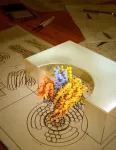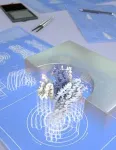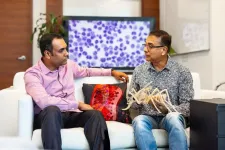DNA Origami nanoturbine sets new horizon for nanomotors
2023-10-26
(Press-News.org)
Nanoturbines: the heart of advancements
Flow-driven turbines lie at the heart of many revolutionary machines that have shaped our societies, from windmills to airplanes. Even life itself depends critically on turbines for fundamental processes, such as the FoF1-ATP synthase that produces fuels for biological cells and the bacterial flagella motor that propels bacteria. “Our nanoturbine has a 25-nanometer diameter rotor made from DNA material with blades configured in a right-handed or left-handed sense to control the direction of rotation. To operate, this structure is docked in a strong water flow, controlled by an electric field or salt concentration difference, from a nanopore, a tiny opening, in a thin membrane. We used our turbine to drive a rigid rod up to 20 revolutions per second”, says Shi.
A fascinating revelation
One of the most intriguing discoveries of this research is the unique nature of the DNA origami nano-turbine's rotation. Its behaviour is influenced by ion concentration, allowing the same turbine to spin either clockwise or anticlockwise, depending on the concentration of Na+ ions in the solution. This unique feature, exclusive to the nanoscale realm, results from the intricate interplay between ions, water, and DNA. These findings, rigorously supported by extensive molecular dynamics simulations by the group of Aleksei Aksimentiev at University of Illinois and theoretical modelling by Ramin Golestanian at MPI Göttingen, hold the promise of expanding the horizons of nanotechnology, and offer numerous applications. For example, in the future, we might be able to use DNA-origami to make nanomachines that can deliver drugs into the human body, to specific types of cells.
DNA origami
Cees Dekker, who supervised the research, sheds light on their methodology: “Together with our collaborators at Hendrik Dietz’s lab from the Technical University of Munich, we used insights from our previous work on DNA rotary motors to now create a turbine with full control over its design and operation”. The ‘DNA origami’ technique uses the specific interactions between complementary DNA base pairs to build dynamic 3D nano-objects. This design allows the direction of rotation of the turbine in our nanopores to be controlled through the handedness of the blades and allows straightforward integration of the turbine to other nanomachines.
A new step towards active transmembrane nanomachines
This research achievement follows last year’s introduction of the DNA active nanorotor, a self-configuring device capable of transforming energy from electrical or salt gradients into practical mechanical work. : TU Delft researchers create flow-driven rotors at the nanoscale
Reflecting on the remarkable journey, Xin Shi underscores the significance of their progress: "We've unveiled the fundamental principles behind propelling a nanoscale rotor using water and salt in nanopores. This year's breakthrough, driven by rational design, marks the next phase of our journey. The foundational principles from our previous paper, combined with the innovations in this one, set the stage for the future of biomimetic transmembrane machines, with the potential to harness energy from salt gradients, a vital energy source employed by biological motors."
END
[Attachments] See images for this press release:


ELSE PRESS RELEASES FROM THIS DATE:
2023-10-26
The National Science Foundation has awarded $3.7 million to the University of Chicago for the first year of a grant that may provide up to $21.4 million for the final designs for a next-generation set of telescopes to map the light from the earliest moments of the universe—the Cosmic Microwave Background.
Led by the University of Chicago and Lawrence Berkeley National Laboratory, the collaboration seeks to build telescopes and infrastructure in both Antarctica and Chile to search for what are known as “primordial” gravitational waves—the vibrations from the Big Bang itself. It would also map the microwave light ...
2023-10-26
The discovery of a malaria protein that helps the parasite grow inside red blood cells and plays a key regulatory role in the parasite’s immune evasion tactics could pave the way for new vaccines or therapeutics to combat the deadly infection.
The protein, known as PfAP2-P, was previously identified in a KAUST-led study that explored malarial genes and proteins displaying rhythmic 24-hour expression patterns — an adaptation that allows the parasite to synchronize its activities with those of the host during the human blood stage of its developmental cycle[1].
The expression levels of PfAP2-P seem to peak first around ...
2023-10-26
Psoriasis — a chronic skin condition — is not caused or spread by spontaneous genetic mutations in the skin, new research suggests.
The team, from the Wellcome Sanger Institute and collaborators, sequenced skin samples from 111 people with psoriasis. They didn’t find any mutated genes in the psoriatic patches that weren’t also mutated in the individual’s unaffected skin tissue.
The study, published today (26 October) in Nature Genetics, suggests that unlike other inflammatory diseases, such as inflammatory bowel disease or chronic liver disease, somatic mutations were not responsible for the start or spread of psoriasis.
Confirming that psoriasis ...
2023-10-26
An international team has developed the first comprehensive framework for designing networks of marine protected areas that can help vulnerable species survive as climate change drives habitat loss.
In a paper published Oct. 26 in One Earth, the researchers outlined guidelines for governments to provide long-distance larval drifters, like urchins and lobsters, as well as migratory species, like turtles and sharks, with protected stopovers along coastal corridors. Led by Stanford marine conservation scientist Nur Arafeh-Dalmau, the team included 50 scientists and practitioners ...
2023-10-26
University of Queensland researchers have shown that endometriosis and irritable bowel syndrome (IBS) share genetic risk factors, explaining why patients with one condition may also have the other.
Professor Grant Montgomery and Dr Sally Mortlock at UQ’s Institute for Molecular Bioscience found a significant relationship between the risks for endometriosis and common gastrointestinal disorders such as IBS, peptic ulcer disease (PUD) and gastro-oesophageal reflux disease (GORD).
“This genetic finding supports the clinical observation of an increased incidence of gastrointestinal disorders in women with endometriosis,” ...
2023-10-26
INDIANAPOLIS -- Two Regenstrief Institute and U.S. Department of Veterans Affairs researchers are key leaders of a national journal’s special supplement designed to help address the plethora of issues that can accompany a healthcare system’s transition to a new electronic health record (EHR) system.
Regenstrief Institute’s David Haggstrom, M.D., MAS, and Michael Weiner, M.D., MPH, are among four guest editors who have spent the last two years leading content development for a Journal of General Internal Medicine (JGIM) special supplement ...
2023-10-26
LOS ANGELES and PHOENIX — City of Hope®, one of the largest cancer research and treatment organizations in the United States, and TGen are leading an international group that has been awarded $4.5 million to validate a liquid biopsy for the early detection of pancreatic cancer. The blood-based diagnostic developed by the National Cancer Institute’s Pancreatic Cancer Detection Consortium (PCDC) leverages exosomal microRNAs that serve as a biomarker or unique RNA fingerprint for the early detection of disease or recurrence.
Enrollment of patients with early-stage pancreatic ductal adenocarcinoma (PDAC), a ...
2023-10-26
(New York, NY – October 26, 2023) – The Icahn School of Medicine at Mount Sinai has received a $4.6 million gift from The Pershing Square Foundation to support women’s health research and advance careers for female scientists. Part of an original nearly $21 million gift that expanded a COVID-19 testing program for New York City schools and other organizations, this boost in women-focused initiatives connects The Pershing Square Foundation’s interest in supporting women in science to Mount Sinai’s leading researchers and key initiatives in gender-based science and health.
“We ...
2023-10-26
SOMERVILLE, Mass., Oct. 26, 2023 – The American Dental Association (ADA) and the Forsyth Institute today announced the formation of the ADA Forsyth Institute, which brings together unparalleled talent, visionary research opportunities and dynamic innovation prospects, dedicated to advancing oral health through scientific innovation and research.
“The new ADA Forsyth Institute will continue to advance oral and overall health through ground-breaking research and innovation,” said Massachusetts Governor Maura Healey. “The Forsyth ...
2023-10-26
The industrial whaling of the 19th and 20th centuries almost wiped out several species. However, even though whaling took place on a much smaller scale before this period, it was enough for at least two species to disappear completely from European waters.
These two species used to be among the most common, but now one of these species is on the verge of extinction.
“Whaling was widespread from a very early time. This had major consequences for species in Europe,” says Youri van den Hurk, a ...
LAST 30 PRESS RELEASES:
[Press-News.org] DNA Origami nanoturbine sets new horizon for nanomotors






